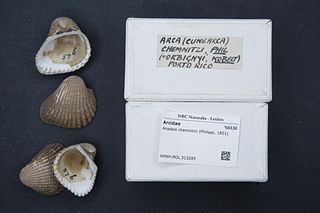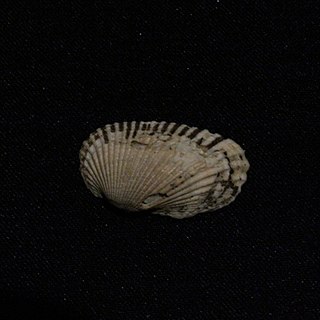
Anadara is a genus of saltwater bivalves, ark clams, in the family Arcidae. It is also called Scapharca.
Nuculana acuta, or the pointed nut clam, is a marine bivalve mollusc in the family Nuculanidae. It can be found along the Atlantic coast of North America, ranging from Massachusetts to Texas, including the West Indies.

Arca imbricata, or the Mossy ark clam, is a clam in the family Arcidae. It can be found along the Atlantic coast of North America, ranging from North Carolina to the West Indies, Brazil, and Bermuda.

Barbatia cancellaria, or the Red-brown ark clam, is a clam in the family Arcidae. It can be found along the Atlantic coast of North America, ranging from Florida to the West Indies.

Barbatia candida, or the White-bearded ark clam, is a clam in the family Arcidae. It can be found along the Atlantic coast of North America, ranging from North Carolina to Texas, including the West Indies.

Barbatia tenera, or Doc Bales' ark clam, is a clam in the family Arcidae. It can be found along the Atlantic coast of North America, ranging from southern Florida to the West Indies.

Anadara brasiliana, common name the incongruous ark clam, is a saltwater clam in the family Arcidae, the ark shells. This species is found along the Atlantic coast of North America, from North Carolina to Brazil.

Anadara chemnitzii, common name Chemnitz's ark clam, is a saltwater clam in the family Arcidae, the ark shells. This species is found in the Caribbean Sea, from Texas to the West Indies and Brazil.

Anadara floridana, also known as Anadara secticostata or the Cut-ribbed ark clam, is a white colored saltwater clam with in the family Arcidae. It can be found along the Atlantic coast of North America, ranging from North Carolina to Texas, including the West Indies. Its shell grows up to 100mm, and the periostracum is dark brown. Its shape is slightly inequivalve, oblong and large. It consists of 30–38 curved radial ribs which increase in width towards the edges. These ribs are faintly incised, the groove is longitudinal.

Anadara notabilis, or the Eared ark clam, is a clam in the family Arcidae. It can be found in Caribbean waters, ranging from Florida to Bermuda and Brazil.

Anadara ovalis, or the Blood ark clam, is a clam in the family Arcidae. It can be found along the Atlantic coast of North America, ranging from Massachusetts to the West Indies and Brazil. It resides from the low-tide line to a depth of ten feet.

Thyasira trisinuata, common name the "Atlantic cleft clam", is a species of saltwater clam, a marine bivalve mollusc in the family Thyasiridae. This species is found along the Atlantic coast of North America, ranging from Nova Scotia to the West Indies.

Chama macerophylla, or the leafy jewel box clam,
is a species of bivalve mollusc in the family Chamidae.
Americardia media, the Atlantic strawberry cockle, is a species of saltwater clam, a marine bivalve mollusc in the family Cardiidae, the cockles. This species can be found along the Atlantic coast of North America, from Cape Hatteras to the West Indies.

Macrocallista maculata, or the calico clam, is a species of bivalve mollusc in the family Veneridae. It can be found along the Atlantic coast of North America, ranging from North Carolina to Bermuda and Brazil.

Liocyma fluctuosa, or the wavy clam, is a species of bivalve mollusc in the family Veneridae. It can be found along the Atlantic coast of North America, from Greenland to Maine, and along the Pacific coast, from Alaska to British Columbia.

Anadara kagoshimensis is an ark clam in the family Arcidae. It can be found in shallow water in temperate parts of the west Pacific Ocean and is cultivated in China, Japan, and Korea for human consumption. It is known as maohan in China and mogai in Japan.
Anadara baughmani, more commonly known as baughman ark or skewed arkis is a saltwater clam in the family Arcidae, which includes the ark shells. This species is found in the Caribbean Sea, Texas, Louisiana, Mississippi and Brazil. It was discovered in 1851.















